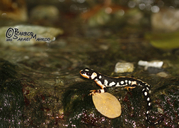|
Neurergus kaiseri Schmidt, 1952
Lorestan Newt, Luristan Newt, Emperor Spotted Newt, Zagros Newt, Iranian Harlequin Newt, Kaiser Newt Subgenus: Neurergus | family: Salamandridae subfamily: Pleurodelinae genus: Neurergus |
 © 2011 Barbod Safaei (1 of 79) |
|
|
|
Description During breeding season, the male cloaca is similar in shape and turgidity to those of other species of Neurergus and breeding Triturus (Sparreboom et al. 2000). The cloaca in breeding females has a tubular extension of about 10 mm (Sparreboom et al. 2000). Distribution and Habitat Country distribution from AmphibiaWeb's database: Iran, Islamic Republic of
Terrestrial habitat includes open woodlands (oak-pistachio forest, on various soil types such as deep sandy loam on valley bottoms or gravelly soils on valley slopes) (Sharifi et al. 2008b). Aquatic habitat varies but tends to be the smaller, slower part of the stream with sand or pebble substrate, less frequently in areas with gravel, cobble, or boulder substrate (Sharifi et al. 2008b). In the area below the Tale Zang waterfall, the stream transitions from a first-order stream to a medium-sized river; there N. kaiseri is found far less frequently, and then only on the fringe of the watercourse where strong currents do not occur (Sharifi et al. 2008b). This species inhabits streams with less vegetative cover than does N. microspilotus, which occurs in a different part of the Zagros Range (Sharifi et al. 2008b). Life History, Abundance, Activity, and Special Behaviors Courtship takes place on land close to the water, with females entering the water to deposit eggs (Rastegar-Pouyani 2003). Detailed observations have been made of courtship behavior in newly wild-caught N. kaiseri (Sparreboom et al. 2000). The male approaches the female slowly and positions himself in front of the female, approximately facing her. He begins tail-fanning in short bouts. When the female signals receptivity by moving towards him, the male steps backward and then turns so that he is creeping ahead of the female, quivering his tail-base rapidly and undulating his tail in agitated movements. The female follows quite closely, touching the male's tail periodically. She may undulate or slowly fan her own tail while following the male. The male will stop moving and undulating but will resume when the female touches his tail. After a number of tail-touches, the male deposits a spermatophore, with his tail slightly raised and slowly undulating in a horizontal plane. He creeps forward more slowly, with the female following and keeping her snout against the lower part of his tail. The male then folds his slowly moving tail against one side of his body, waving the tail-tip occasionally over his back, and slowly turns to a right-angle with the female. He then stops, which brakes the female at about one body-length past the spermatophore, so that her cloaca is situated approximately above where the spermatophore was deposited. After braking, the male may resume creeping in a slightly different direction (and may possibly deposit more spermatophores; other Neurergus species were observed to do this, but it is not clear whether N. kaiseri will deposit multiple spermatophores), or may resume tail-fanning (Sparreboom et al. 2000). In N. kaiseri, male tail-fanning is done mainly with the distal third of the tail, resulting in a motion with smaller amplitude than is observed for tail-fanning in the other three species of Neurergus (N. crocatus, N. microspilotus, N. strauchii) (Sparreboom et al. 2000). Females also sometimes display with their tails. Both N. kaiseri and N. strauchii females occasionally display the "static flamenco" behavior after spermatophore pick-up, where the female holds her tail up and stretches it (Sparreboom et al. 2000). The significance of this display is not known, but it has also been described for Ichthyosaura alpestris (Denoël 1996). The female deposits eggs singly in the water, on rough surfaces such as stones, away from the light but not always on the underside (Sparreboom et al. 2000; Rastegar-Pouyani 2003). Egg deposition has also been reported to occur in small clumps as well as singly on aquatic vegetation or rocks (Sharifi et al. 2008b). Neurergus larvae metamorphose in about two months in the wild (Rastegar-Pouyani 2003). Both the breeding period and larval development period are considerably shorter for N. kaiseri, which relies on water resources with unstable availability, than for the other Neurergus stream-breeding species (Schmidtler and Schmidtler 1975). Migration has not been observed, but Sharifi et al. (2008b) found very few female specimens from March 26-29, 2003, implying that migration from winter hiding places to their aquatic breeding habitat had not been completed by the end of March. Lifespan in the wild is not known, but in captivity N. kaiseri is reported to live at least 6-8 years (Olsson 2009). Trends and Threats A captive breeding program is in place at the Sedgwick County Zoo in Wichita, Kansas, which now has hundreds of surplus captive-bred N. kaiseri. The Sedgwick County Zoo has found that captive N. kaiseri will breed in both moving water and still water systems, and juveniles have been raised successfully in both aquatic and terrestrial environments (N. Nelson, pers. comm.). An in-situ captive breeding program may possibly be undertaken at Razi University in Iran, which has conducted field surveys of Iranian Neurergus and which has successfully bred the related species N. microspilotus using artificial streams (M. Sharifi and T. Papenfuss, pers. comm.). Captive husbandry guidelines for Neurergus kaiseri (Olsson 2009) have been posted to Amphibian Ark and are available on the Amphibian Ark download page in .pdf format. Possible reasons for amphibian decline Dams changing river flow and/or covering habitat Comments Neurergus kaiseri has become the first example of a species granted international protection due to e-commerce. As of March 21, 2010, N. kaiseri is protected under Appendix I of CITES (Convention on International Trade in Endangered Species), which bans export/import of this species. N. kaiseri occurs in only four streams in the southern Zagros Mountains in Iran, and after 10 years of decline, fewer than 1,000 individuals remain in the wild. Specimens have been exported to European countries and to Japan, in violation of Iranian law (see Proposal 14 on Neurergus kaiseri, submitted to the 2010 CoP15 meeting, available online). The Zagros Newt bears the unfortunate distinction of being the sole salamander on the IUCN Species Survival Commission's list of 100 most endangered species announced September 2012 (Baillie and Butcher 2012).
References
Baillie, J.E.M., and Butcher, E.R. (2012). Priceless or Worthless: The world's most threatened species. Zoological Society of London, London, United Kingdom. Barani, H., Torky, F., and Sharifi, M. (2009). ''Reports of new habitats for Neurergus kaiseri in southern Zagros Mountains, Iran.'' Submitted, Hamyard Denoël, M. (1996). ''Etude comparée du comportement de cour de deux sous-espèces du triton alpestre.'' Cahiers d'Ethologie, 21, 133-258. Olsson, H. (2008). Management guidelines - Neurergus kaiseri.pdf. Written by the Director of the Parken Zoo, Eskistuna, Sweden. Available online at amphibianark.org/downloads.htm Rastegar-Pouyani, N. (2006). ''Conservation and distribution of Neurergus microspilotus (Caudata: Salamandridae) in the Zagros Mountains, Kermanshah Province, Western Iran.'' Herpetologia Bonnensis II. Proceedings of the 13th Congress of the Societas Europaea Herpetologica. M. Vences, J. Köhler, T. Ziegler, and W. Böhme, eds. Schmidt, K. P. (1952). ''Diagnoses of new amphibians and reptiles from Iran.'' Natural History Miscellanea, 93, 1-2. Schmidtler, J. J., and Schmidtler, J. F. (1975). "Untersuchungen an westpersischen Bergbachmolchen der Gattung Neurergus." Salamandra, 11, 84-98. [link] Sharifi, M., Papenfuss, T., Rastegar-Pouyani, N., Anderson, S., and Kuzmin, S. (2008). Neurergus kaiseri. In: IUCN 2009. IUCN Red List of Threatened Species. Version 2009.1. www.iucnredlist.org. Downloaded on 31 August 2009. Sharifi, M., Rastegar-Pouyani, N., Akmali, V., and Narengi, S. A. (2008). ''On distribution and conservation status of Neurergus kaiseri (Caudata: Salamandridae).'' Russian Journal of Herpetology, 15, 169-172. Sparreboom, M., Steinfartz, S., and Schultschik, G. (2000). ''Courtship behavior of Neurergus (Caudata: Salamandridae).'' Amphibia-Reptilia, 21, 1-11. Steinfartz, S., Hwang, U. W., Tautz, D., Öz, M., and Veith, M. (2002). ''Molecular phylogeny of the salamandrid genus Neurergus: evidence for an intrageneric switch of reproductive biology.'' Amphibia-Reptilia, 23, 419-431. [link] Originally submitted by: Kellie Whittaker (first posted 2009-07-23) Edited by: Michelle S. Koo, Kellie Whittaker, Ann T. Chang (2013-05-21) Species Account Citation: AmphibiaWeb 2013 Neurergus kaiseri: Lorestan Newt <https://amphibiaweb.org/species/4259> University of California, Berkeley, CA, USA. Accessed May 29, 2025.
Feedback or comments about this page.
Citation: AmphibiaWeb. 2025. <https://amphibiaweb.org> University of California, Berkeley, CA, USA. Accessed 29 May 2025. AmphibiaWeb's policy on data use. |



 Raffaëlli Account
Raffaëlli Account Map of Life
Map of Life Featured in Amazing Amphibians on 20 May 2013
Featured in Amazing Amphibians on 20 May 2013